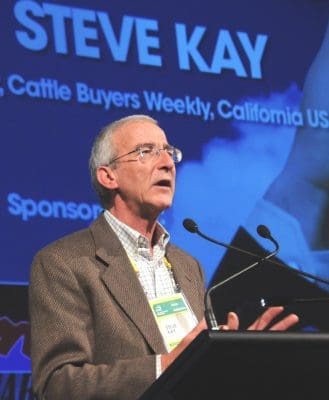 A monthly column written for Beef Central by US meat and livestock industry commentator Steve Kay, publisher of US Cattle Buyers’ Weekly
A monthly column written for Beef Central by US meat and livestock industry commentator Steve Kay, publisher of US Cattle Buyers’ Weekly
QUIET but significant changes are taking place in the US beef processing sector. Although three companies still dominate the sector, processing 60.4 percent* of all commercial slaughter cattle in 2019, smaller players and now a new entrant are giving lie to the long-held feeling that the ‘Big Three’s’ size precluded new entrants.
The changes began when long-established cow processor Caviness Beef Packers, based in Amarillo, Texas, joined forced with agri-giant JR Simplot Company, based in Boise, Idaho, to open CS Beef Packers in 2017. The brand-new 1700 head per day plant is in Kuna, Idaho, and processes all classes of cattle.
Alternative model
Then in August last year, Agri Beef Co, also based in Boise, unveiled plans for a new beef processing plant in Jerome, Idaho, that will process 500 head per day. It will be an alternative model in an industry dominated by large plants and is exactly what some people had been calling for as they expressed concerns about how the COVID pandemic temporarily closed several of the largest plants.
The venture will be different in another way. Agri Beef will be the majority owner of the plant but cattle producers and feeders in the region will also will be equity owners. Agri Beef is already the US industry’s 11th largest beef processor with a capacity of 1550 head per day at its plant in Toppenish, Washington, and a major cattle feeder. Agri Beef hopes the Jerome plant will open late next year or in early 2022. Once it reaches its 500 head of capacity, Agri Beef will become the industry’s eighth largest beef processor in the US.
The plant will be a big boost to Idaho’s cattle producers. The state has consistently ranked in the mid-tier of states in terms of overall cattle numbers, beef cow numbers, the number of cattle on feed and the number marketed. But it has long lacked any beef processing capacity. A 500 head per day plant in Nampa, Idaho, that processed fed cattle closed in 2003. It subsequently reopened as a non-fed (cows and bulls) processor but closed in 2011. Tyson Foods earlier closed its Boise fed beef plant in 2006.
Idaho on January 1 last year had 2.49 million cattle and calves. These included 635,000 dairy cows and 495,000 beef cows. Idaho feedlots marketed 477,000 cattle in 2019. Half of these went south to JBS USA’s Hyrum, Utah, plant and the remainder to Agri Beef’s Toppenish plant or Tyson Foods’ Pasco, Washington, plant. Idaho had 285,000 head on feed on January 1. So the new plant will have a good supply of cattle to draw on.
New producer-owned plant in Missouri
Meanwhile, Missouri is about to get a similar-sized plant and its first in many years. Missouri Prime Beef Packers plans to start operating a 33,000sq m facility in Pleasant Hope early this month. The plant’s initial goal is to harvest 500 fed and non-fed cattle per day, which will give the state’s cattle feeders and cow-calf operators their first processing outlet inside the state. Suffice to say, the plant was in the developmental stage long before the pandemic impacted large plants.
The plant is unique, as it is owned by long-time cattle producers who also operate a beef marketing company. Missouri Prime’s co-owners are NextGen Cattle Co, and cattle producer Stacy Davies. He also manages a 1.5 million acre ranch in Roaring Springs, Oregon, that runs up to 10,000 cows. NextGen Cattle Co, founded in 2016, is involved in seedstock development, cow/calf production and cattle feeding. It and Davies co-own NextGen Beef Co, a beef marketing firm that focuses on consumer demands.
The Pleasant Hope plant previously operated as a pork processing plant under the name Moon Ridge Foods for less than 18 months until 2018. It was originally designed and constructed as a beef processing plant so upgrades and modifications were relatively straightforward.
Obtaining cattle will likely be no issue for the plant. Missouri is the third largest cow-calf state in the US. It had 2.083 million beef cows on January 1, 2020. Missouri Prime estimates there are one million beef cows within a 50-mile radius of the plant. The state’s big issue is that it has no large feedlots for finishing cattle. It does not feature in the 12 states in USDA’s monthly Cattle on Feed report.
To overcome this, Missouri Prime’s owners have worked with at least six small feedlots to get them to become regular suppliers. NextGen Cattle Co also owns and operates a 47,000 head feedlot near Hugoton, Kansas, and a soon-to be 14,000 head feedlot in Allen, Kansas. Cattle from these feedlots will go to the new plant for processing and to support some of the six brands that NextGen Beef Co markets beef under. It. began marketing beef in June 2019.
Thus in two bold moves, it seems that far-sighted individuals have already addressed the concerns expressed last summer. Maybe the Jerome and Pleasant Hope plants will inspire other similar plants to emerge, maybe in the Upper Midwest or on the East Coast.
- The annual Top 30 Beef Packers report compiled by Cattle Buyers Weekly shows that the top three operators – Tyson, JBS USA and Cargill – controlled 60.4pc of the US commercial cattle slaughter in 2019. The top five operators, extended to include National and American Foods Group, controlled 76.1pc.
